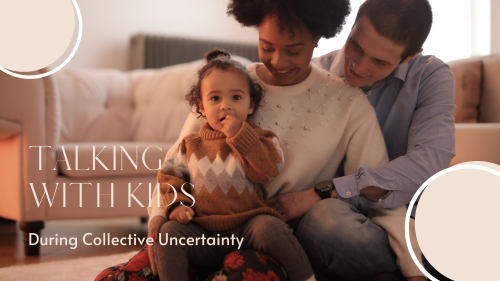 By Holly Schweitzer Dunn, LISW
By Holly Schweitzer Dunn, LISWAnother terribly confusing, scary crisis. Watching a mob of angry people flood into a building that is a symbol of everything we take for granted- freedom, safety, personal opinion, free speech, cooperation, working for the greater good- in our democratic society glued me to my tv and phone. I permitted my children extra video game time knowing they were wearing headsets and interacting in all their tween glory with their friends, unaware of yet another trauma unfolding while I tried to make dinner, reading and re-reading the recipe, the details and steps not able to hold together in my mind. I wanted them to be unaware, at least until I could wrap my brain around what was happening and how to explain it to them.
Just as we were all beginning to feel a little hopeful that the Covid vaccine would turn life back to normal we were subjected, again, to fear and uncertainty. This time it was at the Capitol Building. Over this past week, many parents have asked the best way to address this with their children. Here are our recommendations:
1. Talk to your kids about what happened. They know more than you think they do and deserve to hear the facts from you. Be sure to use developmentally appropriate language and detail. A typical three year old does not have the emotional or mental capacity to understand the complexities of mob mentality and perception. They do, however, understand that different people have different opinions and that everyone wants treated fairly and deserves to live in safety. They also understand that leaders and words have power.
2. Share still images that allow your children to have accurate mental images. Showing an entire video of the Capitol break-in is probably not appropriate for most school age children. Allowing them to see images of broken windows, the women carrying to safety the case of electoral college votes, or protestors gathering outside the Capitol building can give them snapshots of the event that fill in the missing pieces they have from the uncertainty and from their lack of life experience.
3. Turn off the radio, tv news, and news notifications on your phone. As caregivers our first and most important responsibility is the safety and well being of our children. Be in control of the information they see and hear in your home. This is also a good time to review the filters and parent controls on your children’s cell phones, computers, tablets and other devices to ensure you are doing your best to safeguard against unwanted information inadvertently entering your home.
4. Remember children need to process the information just as adults need. In young children this looks like playing out their reality. You may see your children re-enacting their interpretation of recent events. You likely have already seen and heard your children play COVID-themed enactments. Older children may talk about it with you or with their friends, draw, write, tweet or post on social media (if permitted) their thoughts, questions, and opinions. This is normal and to be encouraged.
5. Encourage action. To regain a sense of empowerment after a trauma finding “doing steps” is key. Helping your children find where their power lies and appropriately exerting it is not only a rebuilding step after a trauma, it is a life lesson they will carry into adulthood. Doing steps can be simple: drawing a picture that tells the story of what happened, saying a prayer or meditation to regain a sense of peace and center, playing outside and breathing in the cold air as a reminder of safety. It can also include writing a letter to a congressperson, talking to someone with differing political views, thinking about someone you know and love who believes differently than you.
